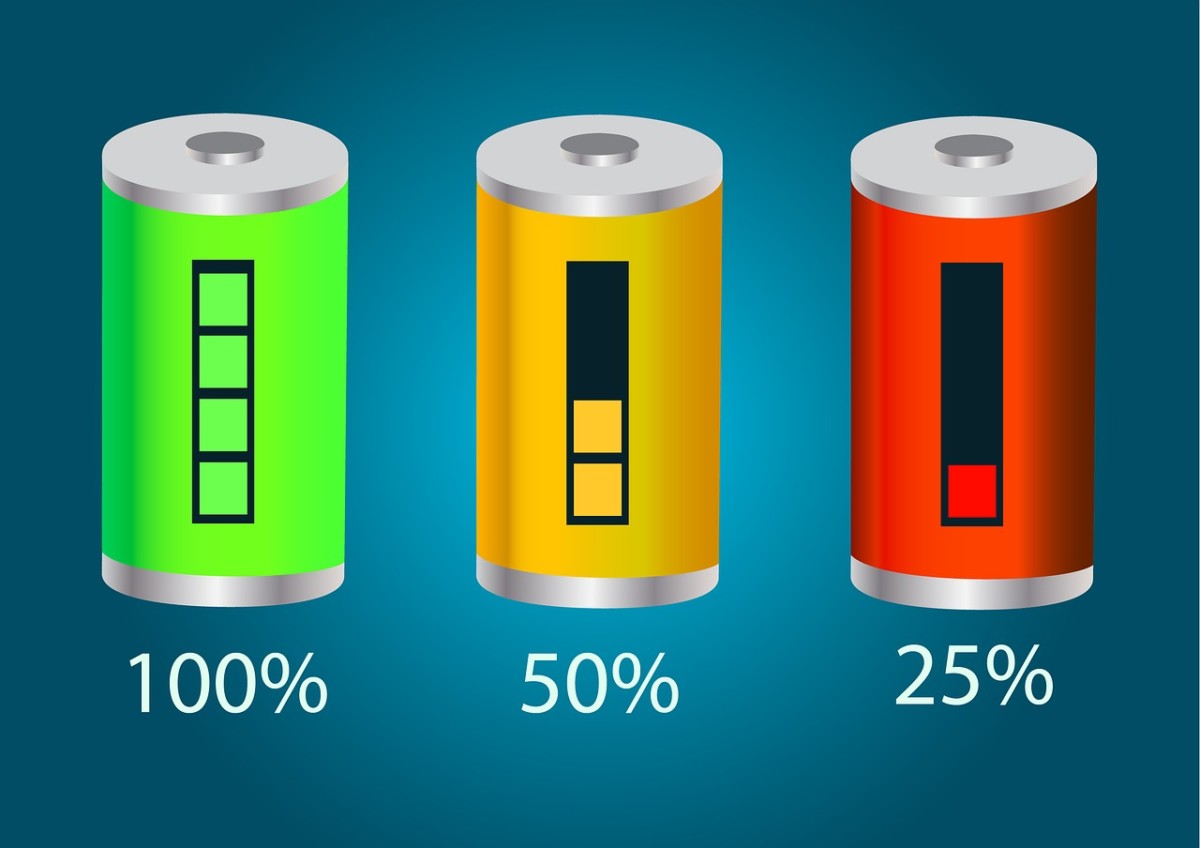How Solar Energy is Stored
This article explores how solar energy is stored. To make it available when needed and maximize its potential.
Solar energy is one of the most abundant forms of energy on Earth and is being used as a renewable form of energy.
As solar energy use continues to rise. It’s important to understand the different options for storing solar energy.
Solar energy’s stored in a variety of ways and used both on-grid and off-grid.
Read on to learn more about how solar energy is stored. Including the different technologies that are used.
Solar energy is a renewable source of energy that’s harnessed through the use of solar panels.
Yet, to ensure continuous power supply even when there is no sunlight.
The energy generated during daylight hours must be stored in solar batteries.
Solar batteries are designed to store and release electricity as needed.
Providing a reliable source of clean energy for homes and businesses.
The process of storing solar energy starts with the conversion of DC electricity. Generated by solar panels into AC electricity through an inverter.
The AC electricity is then used to power household appliances. While excess power gets stored in batteries for later use.
When there is no sunlight, the battery releases its stored energy. To maintain a constant power supply to cover the electricity demand.
Solar batteries come in different sizes and capacities depending on individual needs.
Homeowners can choose from different types. Such as lead-acid, lithium-ion, or flow battery systems.
Based on their budget and specific requirements.
With advancements in technology, solar batteries have become more efficient and durable.
Making them a practical solution for sustainable living.
How Solar Energy is Stored
Benefits of Storing Solar Energy
One of the primary benefits of storing solar energy. Is that it provides a reliable source of electricity even during power outages.
While traditional grid-tied solar systems are designed to shut off during blackouts.
A battery storage system can continue to produce and use energy. Providing an uninterrupted supply of power for your home or business.
Another advantage of storing solar energy is. Is that it allows you to maximize the value of your solar investment.
By storing excess energy produced during sunny hours and using it when the sun is not shining.
You can reduce your reliance on expensive peak-hour grid power. And reduce electricity costs.
Additionally, many utility companies offer time-of-use rates that incentivize off-peak consumption.
Storing solar energy can help you take advantage of these lower rates and save money over time.
You could also sell the excess electricity back to the electricity grid.
Finally, by investing in battery storage systems for your solar panels. You’re helping to reduce our dependence on fossil fuels.
And promote a cleaner environment, plus helping the fight against climate change.
As more individuals and businesses adopt renewable energy sources like solar power.
The demand for traditional carbon-emitting sources will decrease.
Leading to reduced emissions and a healthier planet for future generations.
How Solar Energy is Stored
Types of Solar Energy Storage Systems
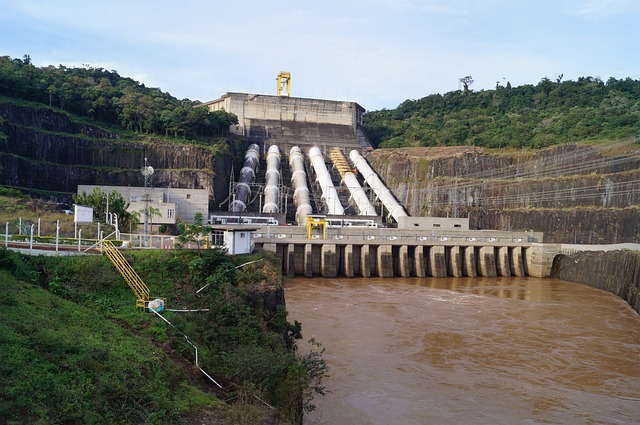
In recent years the growth of solar energy usage has driven the development of various types of energy storage systems forward.
One type of system is the battery-based energy storage system. Which stores excess solar power in batteries for later use.
Another type is thermal storage. Which stores heat from the sun using a heat exchanger and uses it for heating or cooling purposes.
Another popular form of solar energy storage is pumped hydroelectric storage. Which pumps water uphill during periods of low demand. And allows it to flow downhill through turbines. To generate electricity during peak demand times.
Compressed air energy storage (CAES) also stores excess solar power. By compressing air into underground chambers or tanks. And releasing it when needed to drive turbines.
These different types of solar energy storage systems provide a variety of options.
For homeowners and businesses seeking to maximize their use of renewable energy sources.
Like solar power while minimizing their reliance on traditional fossil fuels.
As technology continues to advance. We can expect even more innovative solutions for storing solar energy in the future.
What is thermal energy storage?
Thermal energy storage (TES) is a process of storing thermal energy to use at a later time.
TES systems store this energy in the form of heat, which releases when needed as either hot or cold air.
This type of storage technology is becoming popular as a renewable energy source. Solar and wind become more prevalent.
One common method of TES used for solar energy storage is called “latent heat storage.”
This involves using materials that can undergo phase changes. Such as from solid to liquid or liquid to gas, to store thermal energy.
When these materials are heated they absorb the heat and change phases. While keeping a constant temperature until all the material has changed phases.
Then, when needed the material releases its stored thermal energy. By returning back to its original phase.
Another TES method involves using rock beds or concrete blocks. For storing heat from solar panels during peak hours when there is excess production.
The stored heat can then be released into buildings. During off-peak hours when the demand for electricity is higher.
By utilizing TES systems alongside renewable energy sources like solar power. We can reduce our reliance on fossil fuels. And move towards a cleaner and more sustainable future.
What is Molten Salt Energy Storage
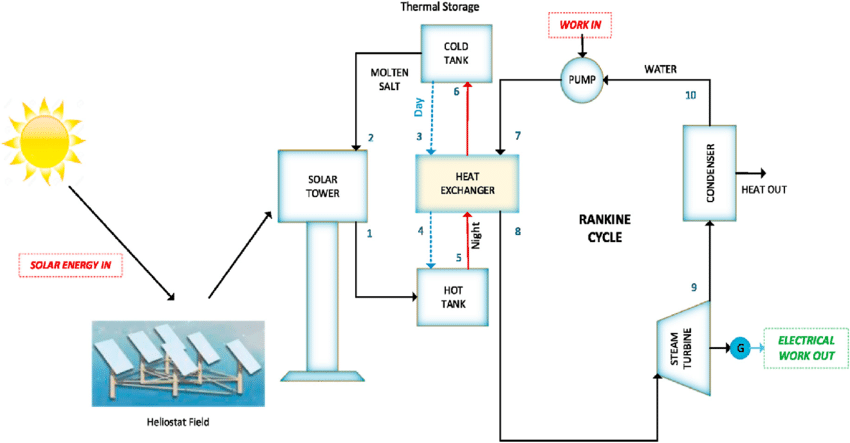
Molten Salt Energy Storage is a type of energy storage. That allows for more efficient and cost-effective use of solar energy.
It involves storing excess solar energy in a mixture of salt and other materials. That can be heated and cooled. Allowing for the stored energy to be utilized when needed.
The process works by using the sun’s rays to heat up the salt, which then retains heat for long periods of time.
The benefits of Molten Salt Energy Storage. Including its ability to store large amounts of energy over extended periods.
Making it ideal for areas where sunlight is limited or intermittent.
It also provides a low-cost alternative to traditional battery storage systems. Which can often be expensive and need frequent maintenance.
Molten Salt Energy Storage offers a promising solution. For those looking to make better use of renewable energy sources like solar power.
With its ability to store excess energy efficiently and effectively.
It has the potential to revolutionize the way we think. About the use of sustainable energy production. In both residential and commercial settings.
How Solar Energy is Stored
The Best Way To Store Solar Energy
There are several ways to store solar energy. But the most efficient and effective method is through batteries.
Lithium-ion batteries are used for this purpose due to their high energy density and reliability.
A lithium ions battery can store excess energy. Generated by solar panels during the day and release when needed.
Ensuring a constant supply of electricity even when sunlight is not available.
Another way of storing solar energy is through thermal storage systems.
These systems use heat from the sun to produce steam. That generates electricity or heats water for later use.
This method is particularly useful in areas with high heat demands. Such as industrial processes or large-scale heating systems.
Finally, pumped hydro storage is another popular way of storing solar energy.
This involves pumping water up a hill during times of excess power generation. And then releasing it back down through turbines to generate electricity when needed.
Though this method requires specific geographical features. It remains a cost-effective option for many regions worldwide.
Regardless of which method you choose. Storing solar power helps reduce dependence on non-renewable resources.
While ensuring a consistent supply of clean energy. Making it an excellent solution for anyone who wants to live sustainably.
While saving money on utility bills.
How Solar Energy is Stored
Cost Considerations for Solar Storage Solutions
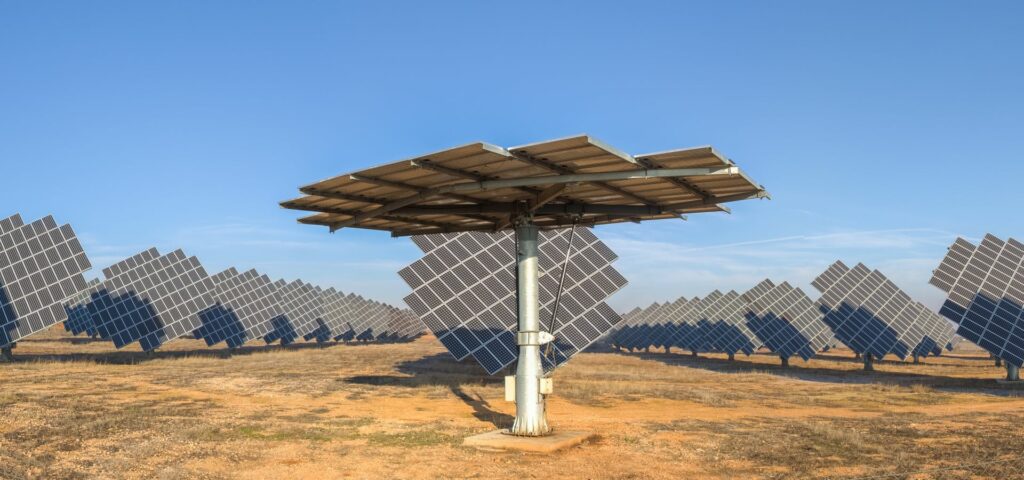
When it comes to solar storage solutions, the cost is a major consideration.
There are several factors that affect the cost of solar storage systems.
Including the size of the system. The type of battery used, and the installation requirements.
Generally speaking. Larger systems with higher-capacity batteries tend to be more expensive than smaller ones.
Another factor that affects cost is the type of battery technology used in the system.
Lithium-ion batteries are currently some of the most popular options for solar storage. Due to their high energy density and long lifetimes.
But, they can be more expensive upfront. Compared to other types of batteries like lead-acid or flow batteries.
Installation costs can also vary depending on many factors. Such as location and accessibility.
Systems installed in remote or difficult-to-reach areas may need extra equipment. And labor which can add to costs.
It’s important for homeowners and businesses looking to invest in solar storage solutions. To consider their needs and budget before making any purchasing decisions.
How Solar Energy is Stored
Technical Requirements for Solar Storage Setups
Solar energy storage has become a hot topic in recent years. As the demand for renewable energy solutions continues to grow.
To effectively store solar energy. There are several technical requirements that must be met.
Batteries used for solar storage setups should have a high capacity. And be able to withstand frequent charge/discharge cycles. Without deteriorating quickly.
Another important factor is the inverter used in the system. The inverter converts DC power from the solar panels into AC power. That can be used by household appliances or fed back into the grid.
It’s crucial to choose an inverter with a high-efficiency rating. So that as little energy as possible is lost during this conversion process.
Monitoring software is also key. When it comes to maintaining and optimizing a solar storage setup.
This software provides real-time information. On how much energy is being produced and consumed.
Allowing homeowners to make adjustments as needed. And ensure they are making the most of their solar investment.
These technical requirements play a vital role. In ensuring efficient and effective solar energy storage.
Technology to help design solar battery storage
One of the biggest challenges in utilizing solar energy is storing it for later use.
This requires a reliable, efficient, and easy way to store the energy that can be accessed when needed.
There are several technology options available to help design solar battery storage.
Lithium ion batteries have become popular. As they offer high energy density and low maintenance requirements.
They are also lightweight and compact. Making them an ideal solution for home or commercial applications.
Additionally, flow batteries that use a liquid electrolyte solution are another option. Providing long-lasting energy storage capabilities.
lead-acid batteries
Lead-acid batteries are a type of rechargeable battery. Commonly used in solar energy systems for storing excess energy.
These batteries work by converting chemical energy into electrical energy. Via a chemical reaction, which can then be used to power homes and businesses.
Lead-acid batteries consist of two lead plates submerged in an acid electrolyte solution.
When the batteries are charged. The lead plates become coated with lead dioxide and lead sulfate. Which stores the electrical charge.
One of the main advantages of lead-acid batteries for solar energy storage is their low cost. Compared to other types of batteries like lithium-ion or nickel-cadmium.
They are also widely available and easy to replace if necessary.
Yet, there are some drawbacks to using lead-acid batteries as well. Such as their relatively short lifespan and lower efficiency compared to newer technologies.
Despite these limitations, lead-acid batteries remain a popular choice for off-grid solar installations. Due to their affordability and reliability.
With continued advancements in technology and research into more sustainable battery options.
It will be exciting to see what innovations come next in the field of solar energy storage.
Moreover, there are digital tools such as software programs and mobile apps.
That can assist with monitoring energy production. And usage patterns to optimize battery storage systems.
Smart inverters can also be used to regulate the amount of power generated by solar panels.
While ensuring the greatest efficiency during charging and discharging cycles.
These technological advancements provide an extensive range of solutions. To meet specific needs for designing efficient solar battery storage systems.
How Solar Energy is Stored
Challenges of Solar Energy Storage
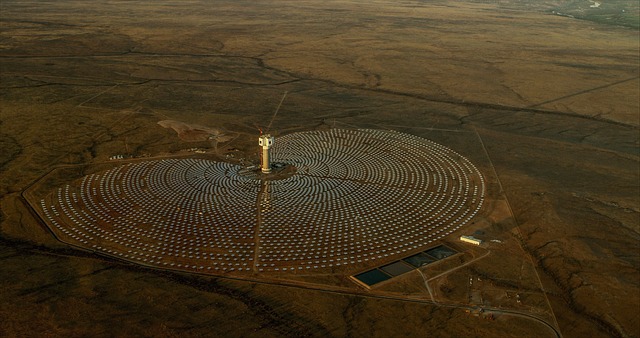
One of the main challenges of solar energy storage. That it requires a significant amount of space.
To store the energy generated during daylight hours.
This can be particularly problematic for residential or small-scale systems. Where available space is limited.
Additionally, storing large quantities of energy in batteries can be expensive. And need ongoing maintenance.
Another challenge associated with solar energy storage. Is a need for efficient and reliable battery technology.
While there have been significant developments in battery technology over recent years.
Current options still have limitations in terms of capacity, lifespan, and cost-effectiveness.
Finally, integrating solar energy storage into existing power grids presents extra challenges.
Often, local regulations may limit the amount of excess solar energy that can be sold back to the grid. At a premium price.
As a result, homeowners may face limited financial incentives. To invest in solar energy storage systems.
Further slowing down adoption rates.
How Solar Energy is Stored
Strategies for Maximizing the Use of Stored Solar Power
Solar energy is stored in batteries that serve as a backup power source when there is no sunlight.
The use of solar energy has many benefits. Including being environmentally friendly and cost-effective in the long term.
To maximize the use of stored solar power, some strategies can be implemented.
One strategy for maximizing the usage of stored solar power. This is to ensure proper maintenance and monitoring of the battery system.
This includes regular checks on the batteries to determine their condition and capacity.
Which will help identify any potential issues before they become major problems.
Additionally, it’s important to ensure that charging levels are optimal. So that the batteries are fully charged when needed.
Another strategy is to focus on energy consumption during peak daylight hours. Such as running appliances or charging electric vehicles.
This will allow excess solar energy generated during peak hours to be stored. For later use when demand exceeds supply.
Finally, investing in smart systems that automatically control devices.
Based on available solar power. Can help optimize energy usage and prevent overloading or underutilizing battery storage capacity.
Such systems can also provide detailed reports on system performance and efficiency levels.
Enabling users to see where further improvements can be made.
How Solar Energy is Stored
How Does A Home Solar Energy Storage System Work?
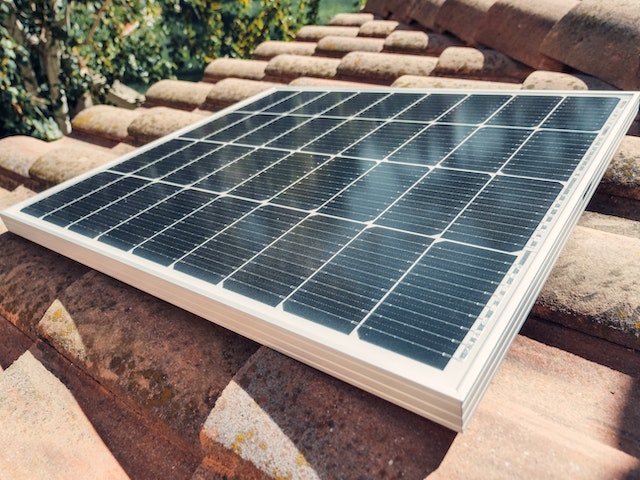
A home solar energy storage system is a device that allows homeowners to store excess energy. Generated by their solar panels for future use.
The solar system consists of a battery bank, an inverter, and a charge controller.
The batteries store the energy. Produced by solar panels during the day when there is plenty of sunlight.
When needed, this stored energy can power your home at night or during periods of low sunlight.
The inverter handles converting the DC electricity. Produced by your solar panels into AC electricity that can be used to power your home.
It also converts AC electricity from the grid back into DC electricity. So it can be stored in your batteries.
A charge controller manages the flow of electricity. Between your solar panels, batteries, and inverter. To ensure that everything works smoothly and safely.
A home solar energy storage system provides several benefits. For homeowners who want to reduce their reliance on traditional fossil fuels. While saving money on their monthly utility bills.
Advances in technology make these systems more efficient and affordable than ever before.
Many people are turning towards renewable sources such as solar power.
As an investment in both their financial future and our planet’s sustainability.
FAQs About How Solar Energy is Stored
What are the common methods of solar energy storage?
The common methods of solar energy storage include:
- Battery Storage: The most popular method, where solar energy is stored in batteries, usually lithium-ion or lead-acid, to be used when the sun isn’t shining.
- Thermal Storage: This method captures and stores excess solar energy as heat, often using materials like molten salt. It can later convert this stored heat back into electricity.
- Mechanical Storage: Pumped hydro storage is a notable example. When there’s excess solar energy, water is pumped uphill into reservoirs. When energy is needed, the water is released to flow downhill, turning turbines that generate electricity.
How is solar energy stored using battery systems, and what are their advantages?
Solar energy is stored in battery systems by converting the direct current (DC) electricity produced by solar panels into alternating current (AC) electricity for household use. Any excess energy is then stored in batteries. The main advantage of battery storage is its ability to provide power during times when there’s no sunlight, like during the night or on cloudy days. This allows for a more consistent and reliable energy supply, reducing dependence on the grid.
Considering the various methods of solar energy storage, which one is the most efficient?
The efficiency of solar energy storage varies depending on the method and technology used. Currently, lithium-ion batteries are among the most efficient methods of solar energy storage, with round-trip efficiencies often above 90%. Thermal storage, particularly when used in concentrated solar power plants, can also have high efficiencies. However, the “most efficient” method can depend on the specific application, geographic location, and energy needs of the user.
Recent Posts
Wind Energy and Its Economic Benefits for Local Communities Firstly wind energy has emerged as a powerful driver of economic development, particularly in local communities. It provides a...
Potential Energy in a Spring: Understanding the Fundamentals
Potential Energy in a Spring Firstly, understanding the potential energy in a spring is fundamental to grasping how energy is stored and transferred in various physical systems. Springs, as...


